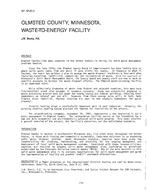
NY-87-20-3 — Olmsted County, Minnesota: Waste-to Energy Facility
Olmsted County–like many counties in the United States–is facing its solid waste management problems head-on.
Since the late 1970s, the Olmsted County Board of Commissioners has been looking hard at where solid waste comes from and where it goes within the county. In response to what it learned , the board has written a plan to manage the waste disposal practices–a four-part plan featuring recycling, landfilling, composting, and incineration of waste. With the approval of Minnesota’s Solid Waste Management Board, the County Board and county staff are now at work on specific projects to balance its waste disposal efforts. The Olmsted waste-to-energy facility is an important start.
While effectively disposing of waste from Olmsted and adjacent counties, this mass burn (incineration) plant also engages in resource recovery. Steam and electricity produced waste processing provide heat and power for nearby county and federal buildings, reducing their dependence on natural gas and oil. Revenues from these energy sales will, in turn, help finance plant operation, thereby reducing the cost to the county’s homeowners for waste disposal.
District heating plays a particularly important part in cost reduction. Uniquely, the existing district heating system provided the impetus for feasibility of the project.
The groundbreaking ceremony, September 26, 1985, represented a new beginning in solid waste management in Olmsted County. The incineration facility serves as the foundation for a new and more economical and environmentally balanced solid waste program. This paper provides a general overview of the project, the facility’s operation, and the anticipated economics.
Units: I-P
Citation: Symposium, ASHRAE Transactions, 1987, vol. 93, pt. 1, New York, NY
Product Details
- Published:
- 1987
- Number of Pages:
- 9
- File Size:
- 1 file , 880 KB
- Product Code(s):
- D-NY-87-20-3


